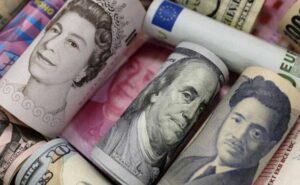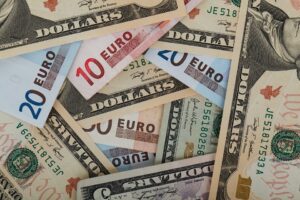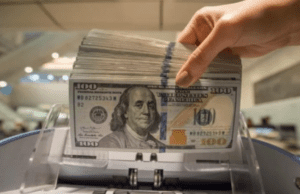
Traders are waiting for inflation data in the U.S. for October, which will be released by the U.S. Labor Department on Thursday at 15:30.
Experts polled by Trading Economics forecast on average a slowdown in consumer price growth in the country to 8% year on year from 8.2% in September.
The U.S. inflation report for October is likely to be a key factor in determining how much the Federal Reserve (Fed) will raise rates at its December meeting.
The market is currently pricing in a 50 basis point (bps) rate hike in December, but a higher-than-expected October inflation rate could shift those expectations in favor of another 75 bps increase, Trading Economics notes.
The ICE-calculated index showing the dynamics of the dollar against six currencies (euro, Swiss franc, yen, Canadian dollar, pound sterling and Swedish krona) is adding 0.28%, while the broader WSJ Dollar is adding 0.33%.
The euro/dollar pair is trading at $0.9950 as of 3:30 p.m. MSC, compared to $1.0014 at market close on Wednesday.
The European Central Bank (ECB) on Thursday took steps to address a shortage of highly liquid government bonds on the market, which are used as collateral in market transactions. The problem has become urgent as the ECB has been buying bonds for years in a row as part of its quantitative easing program.
On Thursday, the ECB decided to increase to 250 billion euros from 150 billion euros the limit for securities lending to financial institutions against cash collateral, said Isabel Schnabel, a member of the ECB’s executive board.
“This is a precautionary measure to alleviate the shortage of securities collateral in the market and keep it functioning at the end of the year,” she wrote on Twitter.
The U.S. currency is at 146.47 yen versus 146.41 yen in the previous session. The pound rose to $1.1392 from $1.1357 the day before.
The dollar/yuan pair is trading at 7.2535 yuan against 7.2419 yuan at the close of the previous session.

The U.S. dollar is strengthening against the euro, yen and pound sterling in trading Tuesday.
The ICE-calculated index showing the dollar’s dynamics against six currencies (euro, Swiss franc, yen, Canadian dollar, pound sterling and Swedish krona) is adding 0.22%, while the broader WSJ Dollar is up 0.14%.
The euro/dollar pair is trading at $1.0007 as of 8:15 a.m., compared with $1.0022 at Monday’s market close.
The U.S. currency rose to 146.67 yen from 146.61 yen in the previous session.
The pound exchange rate fell to $1.1491 from $1.1514 the day before.
Traders’ attention this week is focused on the inflation data in the U.S. for October, which will be published by the Labor Department of the country on Thursday. Experts polled by FactSet are predicting, on average, a slowdown in U.S. consumer price growth to 8 percent year-over-year, down from 8.2 percent in September.
October U.S. inflation data will likely be a key factor in determining how much the Federal Reserve (Fed) will raise the benchmark rate at its December meeting.
Last Wednesday, the Fed raised rates by 75 basis points (bps) for the fourth consecutive meeting, to 3.75-4% per year, the highest since January 2008. U.S. Central Bank Chairman Jerome Powell said that the Fed could begin discussing a slowdown in the rate hike as early as the December meeting. At the same time, he stressed that it was too early to talk about stopping the cycle of rate hikes, and its limit will be higher than previously expected.
President of the Federal Reserve Bank (FRB) of Boston Susan Collins, speaking at the Brookings Institution, said that in December the Fed will discuss the possibility of another rate hike of 75 bps, as well as its less significant increase – 50 bps.

The US dollar is depreciating against the euro, yen and pound sterling in trading on Wednesday, the market awaits the results of a two-day meeting of the Federal Reserve System (Fed).
Traders have no doubt that the rate will be increased by 75 bp following the November meeting. for the fourth time in a row, and their focus is on statements by Fed Chairman Jerome Powell on the further pace of policy tightening.
Signals of persistent inflationary pressures require the US Central Bank to continue to raise rates, but some of its leaders have already made it clear that they consider it necessary to slow down the rate of increase and assess the economic consequences of earlier measures, The Wall Street Journal notes.
Many economists warn of the risks of the Fed tightening too much, which could trigger a severe economic downturn.
“The Fed will have to think about policy adjustments at the November meeting. They are trying to ‘cool’ the economy, not lead it to a deep freeze,” said KPMG chief economist Diane Swank, quoted by the WSJ.
Experts polled by Bloomberg expect the Fed to slow down the rate hike in December to 50 bp, after which it will raise it two more times by 25 bp. at the beginning of 2023.
The ICE-calculated index, which shows the dynamics of the dollar against six currencies (the euro, the Swiss franc, the yen, the Canadian dollar, the pound sterling and the Swedish krona), is losing 0.2% on Wednesday, the broader WSJ Dollar – 0.24%.
The euro/dollar pair is trading at $0.9893 at 9:00 AM, compared to $0.9874 at the market close on Tuesday.
The US dollar against the yen fell to 147.52 yen against 148.24 yen in the previous session.
The pound rose to $1.1510 from $1.1482 on Tuesday.
The Bank of England is also holding a meeting this week, its results will be made public on 3 November. Experts expect the British Central Bank to raise the base rate by 75 bp. – until 3%. The Bank of England did not raise the rate by more than 50 bp. since 1989, notes FT.

The US dollar strengthens against the euro, yen and pound sterling in trading on Monday.
The market is waiting for the meeting of the Federal Reserve System (Fed), which will be held on November 1-2. Traders are confident that the US Central Bank will raise the base interest rate by 75 basis points (bp) following the results of the fourth meeting in a row. As a result, the rate will reach the level of 3.75-4% – the maximum since December 2007.
Traders will be closely watching Fed Chairman Jerome Powell’s statements to see if the US central bank intends to slow down the pace of policy tightening from December, writes the Financial Times newspaper. The global economy is weakening, and experts are already seeing signs that the peak of inflation in the United States has passed. In this regard, investors are increasingly expressing fears that the Fed may overdo it with raising rates and provoke an excessive recession in the economy.
The ICE-calculated index, which shows the dynamics of the dollar against six currencies (the euro, the Swiss franc, the yen, the Canadian dollar, the pound sterling and the Swedish krona), adds 0.08% on Monday, the broader WSJ Dollar – 0.19%.
The euro/dollar pair is trading at $0.9946 as of 8:55 am KSK, compared to $0.9966 at market close on Friday.
The US dollar against the yen rose to 147.92 yen against 147.48 yen in the previous session.
The pound dropped to $1.1592 from $1.1617 on Friday.
The Bank of England is also holding a meeting this week, its results will be made public on 3 November. Experts expect the British Central Bank to raise the base rate by 75 bp. – until 3%. The Bank of England did not raise the rate by more than 50 bp. since 1989, notes FT.
The dollar against the yuan edged up to 7.2698 yuan from 7.2525 yuan at market close on Friday amid weak economic data from China.
The Purchasing Managers’ Index (PMI) for China’s manufacturing industry fell to its lowest level since July of 49.2 in October from 50.1 a month earlier, according to data from the National Bureau of Statistics of the People’s Republic of China (GSO). An index value below 50 points indicates a decline in activity in the sector.
PMI services in China in October fell to 48.7 points, dropping below 50 points for the first time since May.

The US dollar is getting cheaper against the euro and the pound sterling at the auctions on Monday, it is stable against the yen.
The ICE-calculated index, which shows the dynamics of the dollar against six currencies (the euro, the Swiss franc, the yen, the Canadian dollar, the pound sterling and the Swedish krona), is losing 0.29%, the broader WSJ Dollar Index – 0.27%.
The euro/dollar is trading at $0.9750 compared to $0.9722 at the market close on Friday.
The rate of the American currency against the yen is 148.72 yen against 148.75 yen following the results of the previous session.
The pound rose to $1.1272 from $1.1183. On Friday, British Prime Minister Liz Truss fired Chancellor of the Exchequer Quasi Kwarteng, appointing Jeremy Hunt to the post.
According to the Financial Times, several British Conservative MPs and prominent figures from the City of London are calling for Truss herself to step down as prime minister after controversial economic decisions that undermined her credibility.
Britain’s new finance minister told the BBC last Sunday, speaking of the possibility of winding down any of the government’s recent stimulus measures, that “nothing is out of the question.”
Later on Monday, Hunt intends to make a statement regarding the country’s medium-term budget.
The dollar rose against the yuan during trading to 7.1996 yuan from 7.1910 yuan at market close on Friday. Chinese President Xi Jinping, speaking at the 20th Congress of the Chinese Communist Party (CCP), which opened on Sunday, signaled that the country’s authorities would continue their tough policy to contain the spread of COVID-19, which has already seriously weakened the country’s economy this year.

US dollar is stable against the euro, strengthening against the yen and the pound sterling on Friday.
The ICE-calculated index, which shows the dynamics of the dollar against six currencies (the euro, the Swiss franc, the yen, the Canadian dollar, the pound sterling and the Swedish krona), adds 0.03% during trading, the broader WSJ Dollar Index loses 0.02%.
The data of the US Department of Labor published the day before showed a weaker-than-expected slowdown in inflation. The CPI rose in September by 8.2% against the same month last year – the lowest rate in seven months. Experts polled by Trading Economics predicted, on average, a slowdown in inflation to 8.1% from 8.3% in August.
Meanwhile, core inflation, excluding the cost of food and energy (Core CPI) accelerated in September to the highest since August 1982 6.6% in annual terms from 6.3% a month earlier.
Published statistical data have strengthened investors in the opinion that the Federal Reserve System (Fed) will continue the rapid tightening of monetary policy. Now traders are waiting for a sharp rise in the rate of the US Central Bank at each of the two remaining meetings of this year, Bloomberg notes.
The euro/dollar pair is trading at $0.9781 compared to $0.9780 at the close of the previous session.
The US currency against the yen is 147.45 yen against 147.22 yen at the close of the market on Thursday.
The pound fell to $1.1322 from $1.1331 the day before.
British Treasury Secretary Kwazi Kwarteng left Washington, where he was meeting with representatives of the International Monetary Fund (IMF), a day earlier than planned. Experts believe that he may abandon part of the tax cuts he announced earlier in order to prevent an economic crisis in the country, the Financial Times writes.
The newspaper’s sources note that the IMF and finance ministers of several other countries recommended that he quickly abandon plans for tax cuts in order to avoid financial problems in the economy.